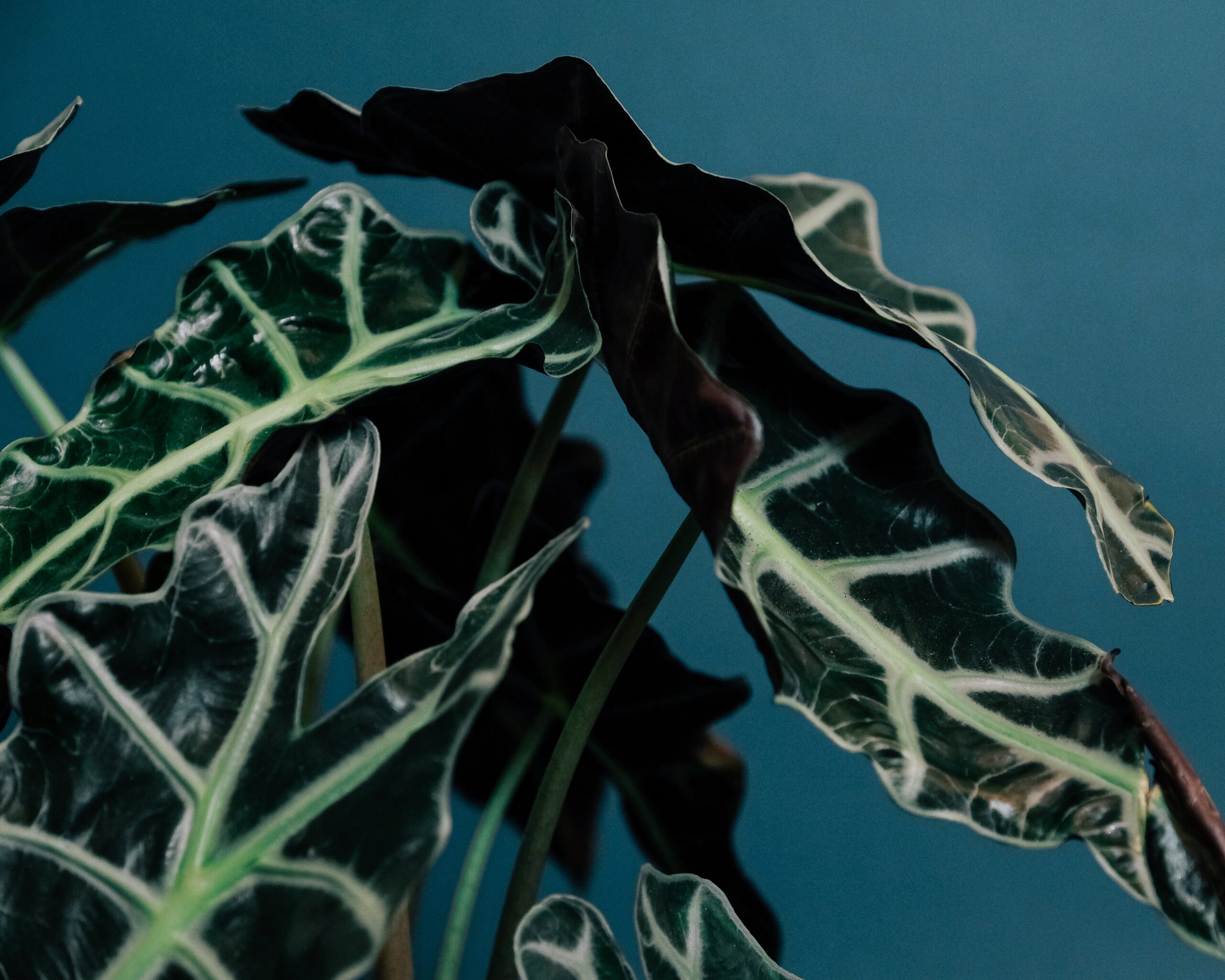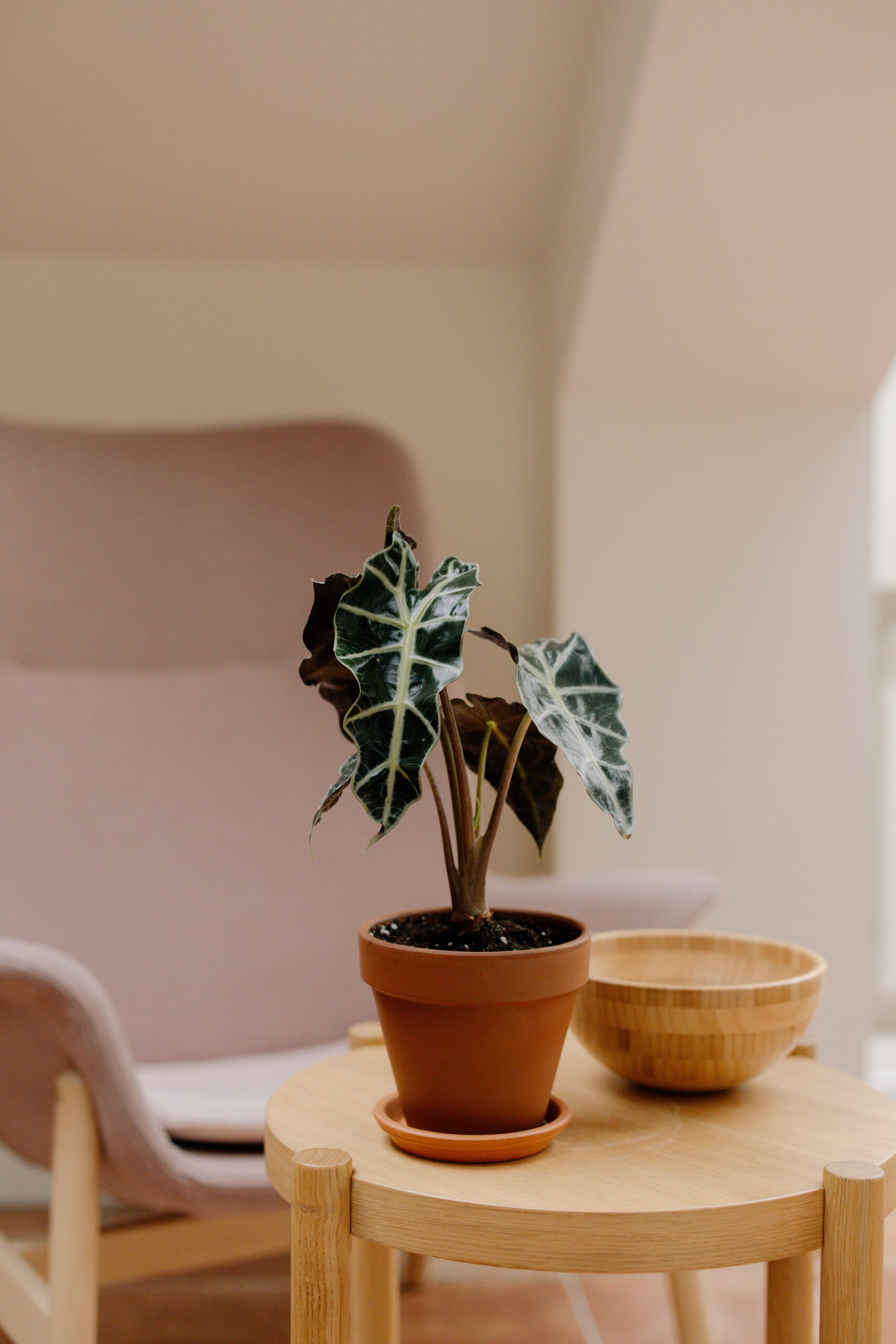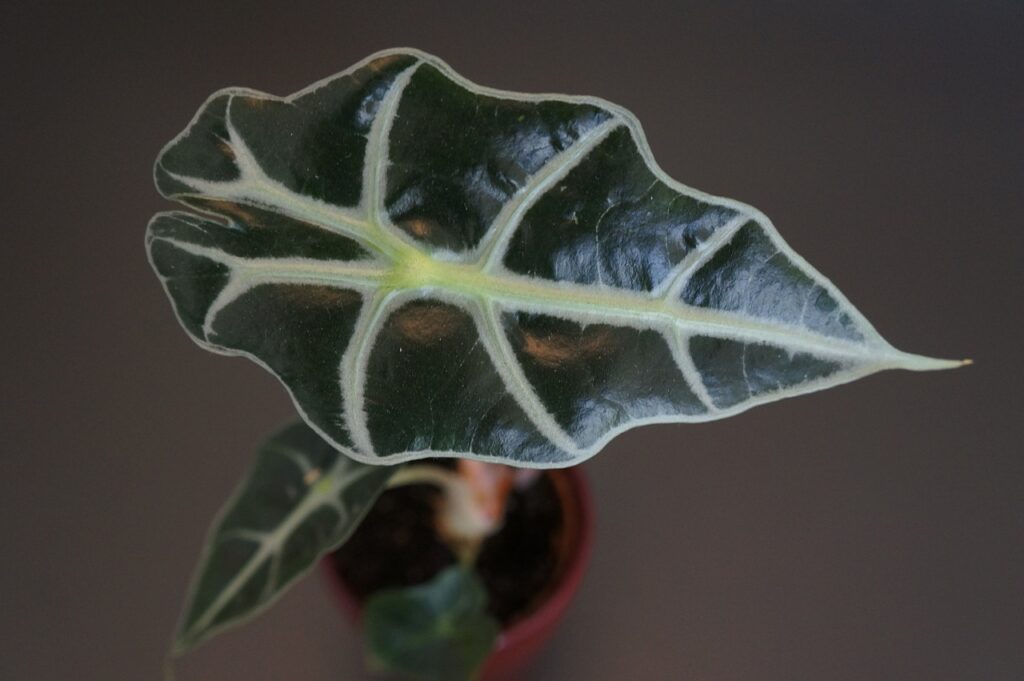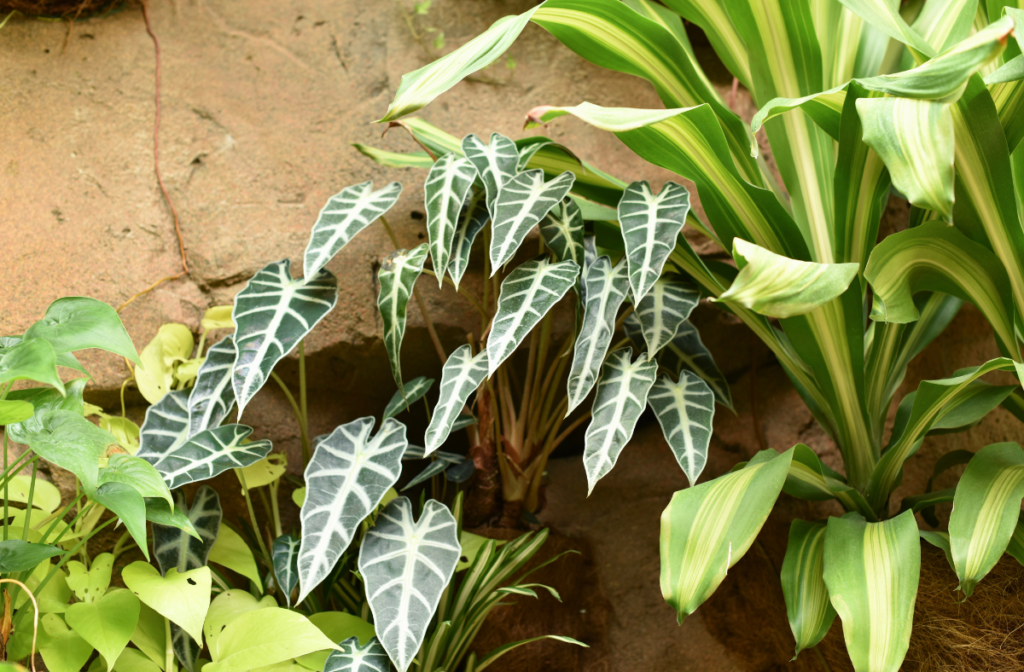One of the most beautiful ornamental plants is the dainty Alocasia Bambino. It has lovely arrowhead green leaves with a purple underside and a light and fashionable striped surface. They are mesmerizing and very convenient to care for indoors. Alocasia Bambino is the easiest plant to grow and the best choice for beginners.

Want to know more? Read more about this beauty below.
Alocasia Bambino Profile
General Information
Also called Bambino Arrow, the scientific name of this dwarf variety is Alocasia amazonica ‘Bambino’. The leaves of this plant can be 15 to 18 cm long and 5 cm wide, given the proper care and nourishment. The narrow leaves of this plant are beautiful, glossy dark green with bright veins.
These plants prefer warmer temperatures because the Bambino is quite intolerant to low temperatures. This plant is found across the tropical and subtropical regions of Asia and Australia. Bambino is a cultivar, which implies it was created by selective breeding and is not naturally occurring.
Etymology
The common name “Bambino” is an Italian word which directly translates to “baby” or “a male child”. This is due to the small stature of this plant.
Flowering
Bambino flowers are produced insignificantly as compared to the foliage. All Alocasia blooms at some stage in the summer and spring, and autumn seasons. However, their primary attraction remains to be their beautiful leaves.
Season Of Interest And Purchasing
The Alocasia Bambino development season happens to be during the summer as well as the spring seasons. It is commercially available all-year round.
Growth
Alocasia Bambino plants seem to exist as the simplest plants to grow. It will grow into a mature plant fairly quickly if properly cared for. With proper care and nutrition, they can grow up to 12 inches tall.
RELATED: Alocasia Imperial Red: A Plant Lover’s Care, Propagation, and Watering Guide
Alocasia Bambino Overview
| Scientific name | Alocasia amazonica ‘Bambino’ |
| Common name/s | Alocasia Bambino, Bambino Arrow |
| Family | Araceae |
| Growth Habit | Herbaceous |
| Height and Spread | 12 – 16 inches |
| Classification based on life cycle | Perennial |
| Origin and Distribution | Native to South East Asia |
| Climate Zone | Generally warmer climate |
| USDA Plant Hardiness Zone | USDA Zone 9 – 11 |
| Color | Glossy dark green with bright veins |
Care Tips

Light Requirement
Alocasia amazonica “Bambino” needs bright, indirect light to keep warm and grow healthy. Direct sunlight will burn the leaves, so make sure to place them in a suitable position inside your homes or gardens. Indoors, it is best to put this in a window corner with a sheer curtain to receive the required type and amount of light.
Temperature Requirement
Every single tropical plant, like Bambino, tends to prefer warmer temperatures. Therefore, the optimum temperature suitable for this plant is between 18 and 22°C. This is an ideal room temperature; hence, this is a perfect plant indoors.
Avoid cold drafts for this plant. Avoid placing it near air conditioners, refrigerators, and other appliances that emit heat. Furthermore, it happens to be pretty intolerant to lower temperatures. Hence, keeping this ornamental plant indoors during the fall or winter months is best.
Water Requirement
You will need to be mindful of how often your plant is watered. Dehydrated roots can quickly harm the Bambino and make it look ill. The same thing can be said about overwatered roots. As a general rule, water your Bambino when the soil has gone dry.
To check if your Bambino needs watering, dip your finger or a stick in the first 3 inches of soil and see if there is still moisture—only water when the soil is dried.
Furthermore, Bambino is not drought-resistant at all. It does not do well under dry, dehydrated conditions, so keep it watered. Watering once or twice a week happens to be enough, depending on the state of the plant and the environment it lives in.
Humidity Requirement
Bambino requires high humidity to thrive. This plant happens to be happiest inside an existing environment that mimics the warm, humid tropical climate to which it is native. If you’ve got a shiny bathroom, the Bambino will fortuitously develop inside of it.
To keep the high humidity conditions, mist the plant frequently using a spray bottle. A pebble tray with water is also an excellent addition to facilitating the moisture and humidity level in the plant’s surroundings.
RELATED: Alocasia Black Velvet: An Instructive Care, Propagation, and Watering Guide
Soil Requirement
Well-draining soil is essential to achieve a healthy growth of Bambino. It is necessary to use a grow pot with a good drainage hole. This plant wants wet soil, however, not in excess. It could not have water compacted across the roots. These houseplants do not tolerate wet feet. The best for Bambino is soil that absorbs the right amounts of water and ground that drains well.
Fill your potting soil mix with peat moss, coco fiber, and perlite to help boost the plant’s health.
Fertilizer Requirement
Fertilizing Alocasia plants is essential to their healthy growth. Fertilize once a month during the spring and summer. This plant needs gentle care in releasing fertilizer so that it grows well and helps it thrive. A slow-release fertilizer would be helpful.
Use a high-quality plant fertilizer to avoid the harmful effects of this plant. Never fertilize with dry soil and when it’s in a dormant period. Always make sure the soil is damp before feeding your plant.
Space Requirement
Bambino is a dwarf kind of the already exceedingly small Alocasia amazonica. This small plant will not grow much taller than 12 feet, so a small space in your room will suffice if you like to take hold of this plant. It is also one of the best decorative plants and is convenient indoors.
Growing and Planting Tips

Propagation
This plant is easily propagated through rhizome division. The first thing to do is choose existing, healthy, and mature plants. Then, take them out by loosening the soil. Next, cut the rhizomes using a sharp knife or cutter. Afterward, put each of them in a separate pot and place them in a location where there is bright indirect light.
You may use a soil mix similar to the mother plant. Always keep the soil moist while the new plants acclimate and develop a good root system. It is best to propagate this plant during its growing season, during the spring and summer months.
Pruning
The pruning requirements for Bambino are incredibly minimal. However, to keep the plant dry, clean, and free of dust, bacteria, and pests, you should groom it regularly. Take out all the dead and damaged foliage to encourage new growth.
Potting And Repotting
Alocasia amazonica “Bambino” is a reasonably slow-growing plant. Please don’t rush into re-potting it. Re-pot the Alocasia every two or three years or when the plant has grown too big. This plant only needs a pot that is just an inch or two larger than the size of the previous pot. Make sure that the pot has efficient drainage holes.
Re-pot Bambino in the summer or spring season since the plant is at its strongest. A well-draining potting mix is also crucial. You can use a standard Aroid mix or a jungle mix to grow this plant.
Alocasia Bambino Care
| Light | Bright indirect |
| Temperature | 18 – 22 degrees Celcius |
| Water | Once a week, increased in summer, decreased in winter |
| Soil | Well-draining and organic |
| Fertilization | Once a month, no fertilization needed in winter |
| Space | Minimal space |
| Propagation | Via rhizome division |
| Blooming | Rarely blooms, enough sunlight and maturity needed |
| Pruning | When needed, removal of damaged and decaying leaves |
| Potting | Regular potting mix or Aroid mix, use of coco fiber, perlite and peat moss recommended |
Pests And Diseases
Alocasia Mickey Mouse Pests And Diseases
| Common Pests/Diseases | Symptoms | Treatment and Prevention |
Common diseases include leaf spotting, root rotting, fungal diseases, stem and crown rotting. | Black or dark brown spots with yellow rim around | Do not overwater and maintain proper humidity levels. Extremely wet environments enhance fungal growth.Proper ventilation is necessary. Removal of infected plant parts to avoid spreading of disease. |
| Common pests include aphids, scales, mealybugs, spider mites | Visible insects thriving on surface | Warm, soapy water can be sprayed once a month. Neem oil, herbal spray, or commercial insecticides can also be used. |
Problem And Troubleshooting
Overwatering
Too much water will cause the roots to be deprived of oxygen due to the waterlogged soil. Then the roots die off, and the plant cannot absorb water, causing the Alocasia leaves to fall off.
The most straightforward way to combat the problem:
- Put your plant in a shady place, even if it is in full sun.
- Check that your pot has adequate drainage and, if possible, create extra air space around the roots.
- Water only when the soil feels dry, but don’t let it get too dry.
- Make sure the correct pot size is used for this plant.
Underwatering
- Your Alocasia Bambino prefers constantly moist pot soil. Make sure you don’t overwater or submerge your plant. Maintain a watering schedule that is consistent.
- If you dry out the soil of your Alocasia plant completely, you may observe the leaves detach, fall off, and possibly have brown tips. If the soil is dried throughout the pot, it will need to be thoroughly soaked.
- Give the Bambino what it needs to ensure adequate hydration.
- Allow your plant to soak up water for at least enough time that it can absorb it.
Nutrient Deficiency
Bambino droopy leaves and brown tips are often caused by nutrient deficiency. This is due to insufficient nutrients in the soil. Rectifying your fertilization schedule to once a month is recommended during spring and summer to mitigate this problem. No fertilization is needed during the fall and winter seasons.
Flowering Problems
Although Bambino is a flowering plant, its flowers are small and insignificant compared to the foliage. Summer and spring are the only times when the Bambino flower blooms. However, the flowering is not reliable for this plant.
Problems With People And Animals
Toxicity
Alocasia plants make stunning houseplants, with the exception that they have the ability to be harmful. It happens to be highly toxic and fatal on the possibility that it is consumed. This is due to the calcium oxalate crystals which are found inside them.
When ingested, the crystals can cause irritation and swelling of the throat. In the worst conditions, it can cause death to both humans and animals.
Alocasia Plants Meaning And Symbolism
In general, Alocasias are said to be the “trees that grow up to heaven” referenced in the classic fairytale “Jack and the Beanstalk.” However, this is botanically incorrect since Alocasias are herbaceous plants and not trees. With this attribute, in general, Alocasias symbolizes risk-taking and seizing opportunities.
The Alocasia bambino also has specific symbolism. Because of its pure and dainty beauty, many people believe that this plant symbolizes all that is good and pure.
Alocasia Bambino Symbolism And Meaning
| General Meaning | “plant that grows up to heavens” |
| Symbolism | Risk taking and seizing opportunities, all that is good and pure |
| Cultural Significance | Attribution to the Jack and the Beanstalk fairytale |
Landscaping And Gardening Ideas

Companion Plants
Alocasia bambino is a stunning tropical plant with arrowhead-shaped leaves, one of the best ornamental species in the Alocasia genus. These plants make excellent companions to other alocasias such as Alocasia Polly, Maharani, and Black Velvet. They are also suitable for planting with other Aroids such as Caladiums, Colocasia, and Xanthosoma.
This plant can be grown along with Canna Lillies, Ornamental Bananas, Dieffenbachias, Coleus, and other low-lying annuals like Petunias to add a more tropical and exotic feel.
Landscaping Ideas
Alocasia Bambino is an excellent border to garden plots since they are small. However, they are best put in front of the other plants rather than in the center since they are quickly overgrown due to their size.
Furthermore, Bambino is a plant suitable for keeping in an enclosed environment such as a bell jar or terrarium. It is also ideal for tabletops and shelves when put in a decorative pot. The Bambino can be a great focal point in these small spaces.
| What to plant with | Colocasia, Caladiums, Alocasias, Xanthosomas, Coleus, Canna Lilies, Ornamental Bananas, Ficus, Dieffenbachia, Schefflera, Castor Beans, Low-lying annuals, Ferns |
| What NOT to plant with | Basically nothing |
Conclusion
Alocasia amazonica “Bambino Arrow” has simply stunning foliage with narrow, distinctive leaves and bright veins. It has a very similar appearance to Alocasia Polly but is smaller; thus, it is also called Jewel Alocasia. This beautiful plant only reaches around 12 and is native to Southeast Asia.
This is one of the best ornamental species and houseplants in the Alocasia genus. This is a reasonably easy houseplant to grow indoors with proper care successfully.
Frequently Asked Questions
Is Alocasia Bambino an excellent indoor plant?
Definitely, yes. Alocasia Bambino is a popular indoor house plant. It thrives in a favorable room temperature, provided that it is placed near a window to get sufficient light. However, please do not allow this plant to get a whole, direct bright light as it will harm their leaves.
Is it rare for Alocasia to flower?
Yes. It is rare to flower Alocasia. However, it is not impossible. Ensure to give a sufficient amount of sunlight to these plants to ensure they flowers when they can. Amount and type of light are critical for flowering since the genes responsible for flowering are light-activated.
Does Alocasia Bambino stay small?
Alocasia Bambino is a dwarf variety of the already small size Alocasia amazonica. The Bambino does not grow larger than 12 inches tall. This is perfect for small spaces like apartments or condominiums. Just put it in a decorative pot, and you’re good to showcase it.
Can you propagate Alocasia Bambino?
Yes. The most successful and proven way to propagate Bambino is through rhizome division. Using a knife or any sharp object, cut a piece of the rhizome from the mother plant and plant it in a proper growing medium. Make sure to place it in a favorable condition while it roots.
When should I report Alocasia Bambino?
The Bambino is known to be a relatively slow-growing plant. Generally, only re-pot plants have already outgrown their pots when roots are already peeping through the drainage holes. This is to avoid overwatering and root rot, which will cause problems for your plant.
Discover more unique plants like the Alocasia Bambino, check out our other articles:
What Type of Pothos Do I Have? Let Us Solve the Puzzle!
How To Grow & Care For Your Monstera Plant? The Ultimate Guide
Hoya Sunrise: The #1 Most Informative Care, Propagation, and Watering Guide







